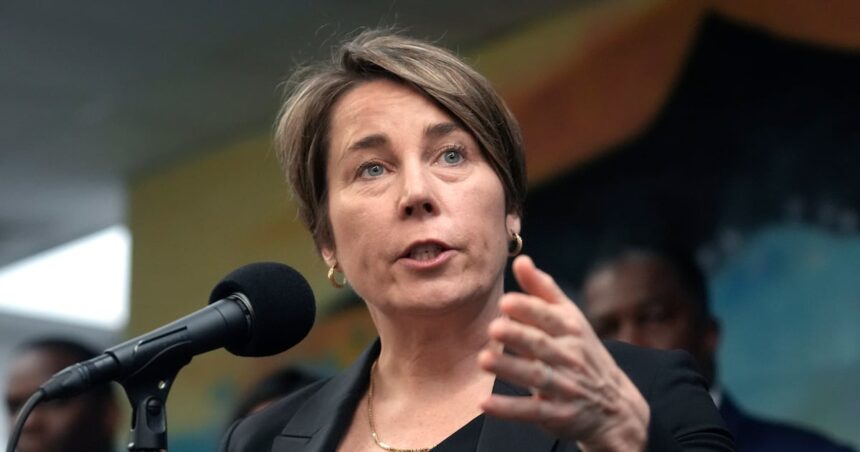When Maura Healey stepped into the Canadian Embassy’s grand ballroom in Washington last Tuesday, tensions between North America’s closest allies had reached a breaking point not seen in decades. The Massachusetts governor’s appearance at what would normally be a routine diplomatic function instead became a platform for an urgent appeal.
“The relationship between our nations has suffered serious damage,” Healey told the assembled diplomats and business leaders. “But we cannot afford to continue down this path of mutual harm. Massachusetts alone has lost over 27,000 jobs directly tied to Canadian trade disruptions.”
Three years into what many analysts now openly call a trade war, the effects have rippled through communities on both sides of the world’s longest undefended border. What began as targeted retaliation to America’s Prioritizing American Manufacturing Act of 2024 has escalated into a comprehensive breakdown of the integrated supply chains that once defined North American economic cooperation.
Speaking with me after her address, Healey didn’t mince words about where responsibility lies. “Washington needs to recognize that pushing Canada to the brink has backfired spectacularly,” she said. “The northeastern states are paying the price for policies crafted without considering regional economic realities.”
The numbers support her concern. According to the Council on Foreign Relations’ latest North American Trade Assessment, cross-border commerce has contracted by 37% since 2023 levels. The most severe impacts have hit the automotive sector, where integrated production lines have operated seamlessly for generations under previous trade agreements.
“We’re seeing the unraveling of decades of integration,” explains Dominique Moisi, a senior adviser at the Institut Montaigne and longtime observer of transatlantic relations. “What makes this particularly troubling is how unnecessary it all seems. Neither country benefits from this estrangement.”
The deterioration began with American lumber tariffs that Canadian officials viewed as violation of existing agreements. Ottawa’s response targeted agricultural products from politically sensitive U.S. states. The spiral continued when Washington restricted Canadian energy imports, prompting Canada to impose new regulatory hurdles for American financial services.
Along the border itself, communities that once functioned as essentially unified economic zones now find themselves casualties of distant political calculations. In Stanstead, Quebec, which shares a library building with Derby Line, Vermont, local business owner Madeleine Tremblay described the impact.
“My customers used to come from both sides without thinking about it,” she told me during a visit to the region last month. “Now with increased inspection times and paperwork requirements, people just stay on their own side. My revenue is down 40% while my compliance costs have doubled.“
Michigan Governor Gretchen Whitmer joined Healey’s diplomatic initiative, noting that her state’s automotive industry has faced parts shortages and production delays costing an estimated $4.3 billion in lost output since restrictions tightened. “This isn’t abstract policy. These are real people losing real jobs in communities that were already struggling,” Whitmer said in a joint statement with Healey released after the embassy event.
Canadian Finance Minister Chrystia Freeland has remained outwardly diplomatic but increasingly firm. “Canada has always preferred cooperation to confrontation,” she said at a Toronto economic forum last week. “But we will continue to respond proportionally to protect Canadian interests until our American friends return to the principles that made our relationship so productive for so long.”
What makes the current impasse particularly frustrating for border state governors is that polling shows strong public support for restoration of normal trade relations. A recent Angus Reid/Pew Research survey found 76% of Canadians and 68% of Americans believe the trade dispute hurts their country more than it helps.
The Massachusetts Biotechnology Council estimates that research collaboration between Boston-area institutions and Canadian counterparts has dropped by nearly 60% as visa restrictions and intellectual property concerns have complicated cross-border scientific partnerships. “We’re cutting ourselves off from innovation at precisely the wrong moment,” council president Robert Coughlin warned.
Environmental cooperation has also suffered. Joint Great Lakes protection efforts have stalled, while carbon border adjustment mechanisms implemented by both countries have created a complex regulatory environment that smaller businesses struggle to navigate.
Border communities like Sault Ste. Marie, spanning Michigan and Ontario, report increases in unemployment and business closures. Mayor Matthew Shoemaker of the Ontario side describes watching a century of integration unravel in just three years. “Families here have relatives, jobs, and connections on both sides. The border was barely noticeable before. Now it’s a wall dividing our community.”
Trade experts point to upcoming provincial elections in Ontario and Quebec as potential turning points, with candidates in both provinces campaigning on platforms that include standing firm against American pressure. This domestic political reality makes it increasingly difficult for Canadian officials to offer concessions without appearing to capitulate.
Standing near the Peace Arch border crossing between Washington state and British Columbia last week, I watched as commercial trucks waited in lines stretching for miles. A border agent who requested anonymity told me processing times have tripled since new inspection requirements were implemented.
“This isn’t what either country wants,” Governor Healey emphasized in our conversation. “But restoring trust requires more than words. It needs concrete policy changes and a genuine commitment to rebuild what we’ve damaged together.”
As the summer diplomatic season approaches, border state governors have emerged as perhaps the most credible voices advocating for de-escalation. Their constituents live with the daily reality of what happens when the world’s most successful bilateral relationship fractures. Whether Washington and Ottawa are prepared to listen remains the critical question for North American prosperity in 2025.






